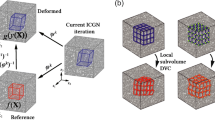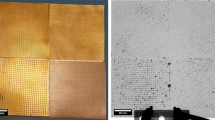Abstract
Volumetric Digital Image Correlation (VDIC) or Digital Volumetric Correlation (DVC) is becoming more widely used in biological research, micro-structural studies in materials, geological sciences and other fields. With DVC, volumetric image sets obtained by X-Ray tomography, magnetic resonance imaging or confocal microscopy can be analyzed to obtain volumetric deformation measurements throughout the interior of a specimen, provided that there is sufficient contrast (local changes in contrast) within the interior region of interest. Using software developed by the authors [1], results from a series of experimental studies on a small circular disk specimen are presented that demonstrate the accuracy of the method when adequate contrast exists.
Access provided by Autonomous University of Puebla. Download conference paper PDF
Similar content being viewed by others
Keywords
- Volumetric images
- Digital volumetric correlation (DVC)
- Internal deformation measurements
- Displacement map
- Strain map
27.1 Introduction
The recent development of efficient 3D imaging tools such as X-Ray Computed Micro-Tomography, combined with the extension of image correlation methods to DVC, opens a wide range of applications for intensive study, including new composite materials. DVC imports volumetric images of the specimen in reference and deformed states and calculate the full 3D displacement and strain map. It is a powerful non-intrusive technique for the identification of sub-surface material deformation and is capable of identifying defects, discontinuities or other material characteristics.
In this study, which follows the work of Bay et al. [2, 3], the correlation computation optimizes the merit function given as:
where N is the total number of voxels in a sub-volume, I is the intensity at a voxel position R(X,Y,Z) in reference (ref) or deformed (def) image set, and a is the shape function. In this study, the shape function is an affine transformation that includes translation, rotation and deformation. It is noted that the effects of rotation are especially important when the sampling frequency is not uniform in all directions; typically image resolution along one direction (e.g., Z) is lower than it is in the other two (e.g., X and Y in an image slice). Strain components at the center of a given sub-volume are obtained by fitting a quadratic polynomial by displacements of all surrounding sub-volumes.
27.2 Results
Figure 27.1a shows a typical horizontal slice through the puck specimen. The 150 × 150 × 150 mm field of view was constructed using 1,000 × 1,000 × 1,000 voxels, resulting in an average voxel size of 0.15 mm in each direction. The cylindrical specimen is 20 mm thick, 75 mm in outer diameter, with a central 25 mm diameter interior hole. The puck is made of rubber that has been seeded with silica particles that range from 0.3 to 0.6 mm in size. The reference image set is acquired before compression is applied along its diametral direction. Figure 27.1b shows the deformed image slice acquired when the vertical diameter is compressed from 75 to 56.25 mm.
Figure 27.2 shows the deformed cross-section that is defined by the dashed line in Fig. 27.1. As shown in Fig. 27.2, the puck cross-section has a trapezoidal shape due to the stress state in the central region of the puck specimen.
Using a 23 × 23 × 23 sub-volume size for DVC throughout the interior of the specimen, Fig. 27.3 shows a vector plot of the computed displacement field on the mid-thickness plane of the puck, with W being the displacement in the vertical (Z) direction and U being the displacement in horizontal (X) direction. It is consistent with the result of FE analysis.
Figures 27.4, 27.5 and 27.6 show the measured strain fields ε xx , ε xy and ε yy , respectively, on the diametric cross-section shown in Fig. 27.2.
Strain ε xx on the diametric cross-section shown in Fig. 27.2
Strain ε xy on the diametric cross-section shown in Fig. 27.2
Strain ε yy on the diametric cross-section shown in Fig. 27.2
27.3 Discussion
Though not shown, finite element results are in very good agreement with the measurements throughout the puck interior, providing a measure of validation for the DVC-based measurements. Additional developments are underway to allow for point-wise particle tracking so that rosette-type interior measurements can be obtained without requiring a dense set of interior markers that may alter the response of the material due to density differences in the materials.
References
Sutton MA, Orteu JJ, Schreier H (2009) Image correlation for shape, motion and deformation measurements. doi: 10.1007/978-0-387-78747-3, Springer
Smith TS, Bay BK, Rashid MM (2002) Digital volume correlation including rotational degrees of freedom during minimization. Exp Mech 42(3):272–278
Bay BK, Smith TS, Fyhrie DP, Saad M (1999) Digital volume correlation: three-dimensional strain mapping using X-Ray tomography. Exp Mech 33(3):217–226
Author information
Authors and Affiliations
Corresponding author
Editor information
Editors and Affiliations
Rights and permissions
Copyright information
© 2014 The Society for Experimental Mechanics, Inc.
About this paper
Cite this paper
Li, N., Sutton, M. (2014). Interior Deformation Measurements Using X-Ray Tomography and Digital Volume Correlation. In: Jin, H., Sciammarella, C., Yoshida, S., Lamberti, L. (eds) Advancement of Optical Methods in Experimental Mechanics, Volume 3. Conference Proceedings of the Society for Experimental Mechanics Series. Springer, Cham. https://doi.org/10.1007/978-3-319-00768-7_27
Download citation
DOI: https://doi.org/10.1007/978-3-319-00768-7_27
Published:
Publisher Name: Springer, Cham
Print ISBN: 978-3-319-00767-0
Online ISBN: 978-3-319-00768-7
eBook Packages: EngineeringEngineering (R0)










